RARE! WWII B-17 Battle of the Bulge BASTONGE Ardennes USAAF Navigators Raid Map
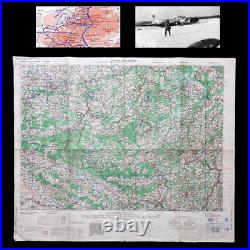

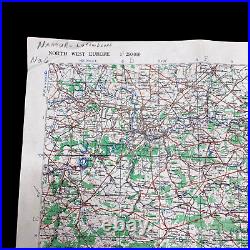
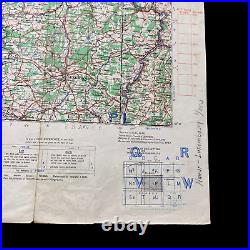
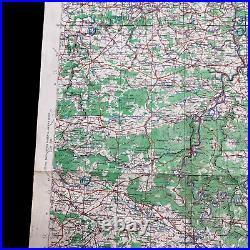
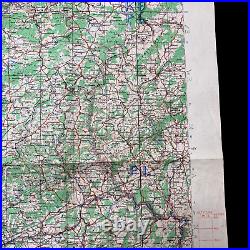
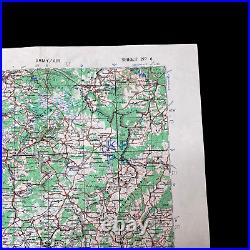
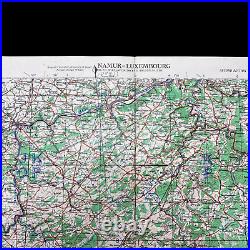
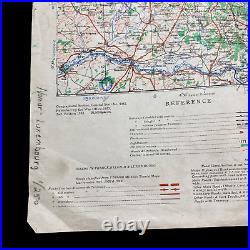
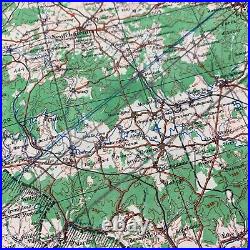
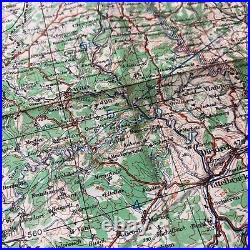
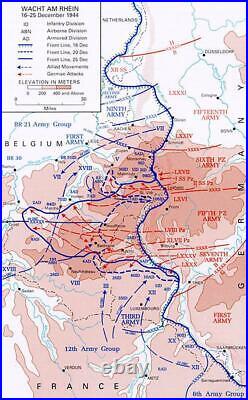

Between December 16, 1944, and January 6, 1945, the Eighth and Ninth Air Forces claimed more than 400 enemy fighters shot down, while the RAF downed hundreds more. Ground forces blunted the German offensive five miles short of the Meuse River, where British troops covered the crossings, the Luftwaffe ceased to exist as a threat in the Bulge. From December 16, 1944, to January 16, 1945, according to the Army Air Forces' official history, planes of the Eighth and Ninth Air Forces destroyed 11,378 German transport vehicles, 1,161 tanks and other armored vehicles, 507 locomotives, 6,266 railroad cars, 472 gun positions, 974 rail cuts, 421 road cuts, and 36 bridges. This incredible and museum-grade WWII 1943 B-17 navigators map was used by one of the B-17s providing air support and supply missions during the Battle of the Bulge. The Battle of the Bulge, also known as the Ardennes Offensive, was a major German offensive campaign on the Western Front during World War II which took place from 16 December 1944 to 25 January 1945.
It was launched through the densely forested Ardennes region between Belgium and Luxembourg towards the end of the war in Europe. Used for Allied aerial support and raid mission this air map shows some of the most important towns and regions in the Ardennse Forrest region including BASTONGE, MARCHE, HOUFFALIZE, LUXEMBURG, MONTMEDY, SEDAN, ETC. Air attacks on German forces and.
Sealed the failure of the German offensive. What makes this map very rare and desirable is that this map contains many hand marked mission navigation lines over the region. Meaning this map was used on multiple B-17 aerial support mission during the Battle of the Bulge. The Fifth and Sixth Panzer Armies and the Seventh Army smashed through thinly held American defense lines and caused panic and confusion at all command levels. The Germans had deliberately waited for a period of bad weather, which was to herald the worst European winter for half a century, to shield their ground operations from overwhelming RAF and USAAF supremacy.
Preciously husbanded fuel, enough for only six days of operations, allowed the German armor to advance and the Luftwaffe to fly. The vile weather, including thick ground fog in England that made takeoffs and landings risky, would not clear for several days, during which U.Units in the sector of the Ardennes foreset were pushed back and severely mauled before regaining their balance. The Luftwaffe supported the counter-offensive with all its capabilities. Some 1,500 fighters, 300 fighter-bombers, and 500 twin-engine fighters and bombers were used in the attack. While shock and indecision paralyzed Dwight D. Eisenhower's headquarters for two critical days, General Carl A.
"Tooey" Spaatz, the commander of the U. Strategic Air Forces in Europe, responded decisively to the American ground force's desperate need for additional air support.
He directed two of the Eighth Air Force's fighter groups to rush from England to the continent and place themselves at Vandenberg's operational disposal. Rising Gallantly to the Challenge.
Despite the treacherous weather conditions of low cloud, fog, snow, and rain, airmen of the Army Air Corps rose gallantly to the challenge. On December 17, a cutting-edge German battle group with 3,500 men and 150 tanks snaking westward along country lanes north of St. Vith, Belgium, was located by two P-38 Lightning fighters and halted by bombing and strafing P-47 Thunderbolts of the 365th and 368th Fighter Groups. This gave First Army combat engineers time to demolish key bridges the enemy needed, and the 1st SS Panzer Division's attack lost momentum. The following day brought a slight clearing of the skies, allowing Anderson's B-26 Marauder medium bombers to wreck a score of bridges, further impeding the German offensive. The Eighth Air Force was able to send out a few missions against tactical targets behind the enemy lines, though the fog in England caused several tragic B-17 collisions and the main bombing force had to stand down for a critical week. Support from RAF Bomber Command.RAF Bomber Command rallied to indirectly assist the Americans at the Battle of the Bulge the week after the panzer breakthrough. In spite of the appalling flying weather, Air Chief Marshal Arthur "Bomber" Harris's heavy Lancaster and Halifax groups mounted large-scale missions against German industrial, rail, and communications centers on four nights and two days. Meanwhile, by December 1944, RAF Bomber Command had devastated or seriously damaged 80 percent of Germany's large cities.
Inside the Battle of the Bulge, the Luftwaffe air crews made the most of the bad weather for the first few days, but then their luck ran out. They were hampered, as were the German ground forces, by a desperate shortage of fuel. British and American bomber groups had been targeting enemy refineries for many months, and German oil stocks were now almost exhausted. Allied fortunes changed for the better on December 23, when an area of high pressure, called a "Russian high" by the meteorologists, dispersed the low clouds and provided five days of acceptable flying weather. Many air groups were able to take off in England and offer tactical support to the hard-pressed U.
Allied air strikes became increasingly effective, battering enemy troop convoys; destroying bridges, supply dumps, and communication lines; and knocking Luftwaffe planes out of the air. The spirits of GIs rose when they heard the steady drone of C-47 transports arriving on December 23 with much-needed cargoes of ammunition, food, and medical supplies. Nowhere was the resupply operation cheered more loudly than in and around Bastogne, where the besieged 101st Airborne Division and attached elements had been waging an epic defense against relentless German pressure.